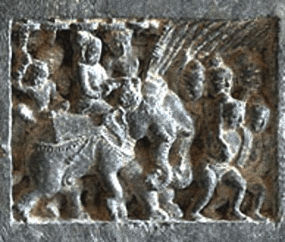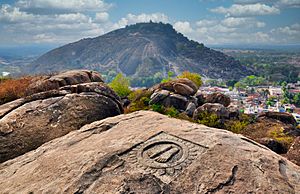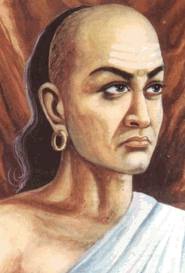Chandragupta Maurya facts for kids
Quick facts for kids Chandragupta Maurya |
|
|---|---|
| Chakravartin | |

Medieval stone relief at Digambara pilgrimage site Shravanabelagola, Karnataka. It has been interpreted as Bhadrabahu and Chandragupta Maurya, but some disagree.
|
|
| 1st Mauryan Emperor | |
| Reign | c. 324 or 321 – c. 297 BCE |
| Coronation | c. 324 or 321 BCE |
| Predecessor | Dhana Nanda |
| Successor | Emperor Bindusara Maurya (son) |
| Amatya |
|
| Spouse |
|
| Issue | Bindusara |
| Dynasty | Maurya |
| Father | Sarvarthasiddhi |
| Mother | Mura |
| Religion | Hinduism Jainism |
Chandragupta Maurya (born around 350 BCE, died around 295 BCE) was the very first emperor of the Maurya Empire in Ancient India. He started a huge kingdom in Magadha and founded the Maurya dynasty. He ruled from about 320 BCE to 298 BCE. His kingdom grew into a powerful empire. It became even bigger under his grandson, Ashoka, who ruled from 268 BCE to 231 BCE.
Chandragupta Maurya was a super important person in history of India. He created the first state that united most of India. With help from his teacher, Chanakya, Chandragupta built a strong army. He kept expanding his empire's borders. Later in his life, he gave up his throne to live a simple, religious life.
Before Chandragupta became powerful, Alexander the Great had invaded parts of North-West India. But Alexander left in 324 BCE. His soldiers didn't want to fight another big empire, probably the Nanda Empire. Chandragupta defeated both the Nanda Empire and the Greek rulers left behind by Alexander. He conquered the Nanda Empire, which was based in Pataliputra. After that, Chandragupta made his western border safe. He even fought Seleucus I Nicator, one of Alexander's generals. After two years of war, Chandragupta won. He gained control of lands up to the Hindu Kush mountains. They made a peace treaty, and Chandragupta married Seleucus's daughter.
Chandragupta's empire covered most of the Indian subcontinent. It stretched from modern-day Bengal to Afghanistan. It also reached into Central and South India. During his rule, Chandragupta allowed many religions to thrive. Buddhism, Jainism, and Ājīvika became popular. Older traditions like Vedic and Brahmanistic beliefs were also respected. Even minority religions like Zoroastrianism and the Greek pantheon were accepted.
Contents
Who was Chandragupta Maurya?
Chandragupta's life and achievements are written about in old Greek, Hindu, Buddhist, and Jain texts. These stories sometimes have different details. Chandragupta was born around 340 BCE and died around 295 BCE.
Ancient Greek and Roman Stories
The oldest stories about Chandragupta come from Greek and Roman writers. One Roman historian named Justin wrote about him in the second century CE. These texts often mention the Nanda Empire, which Chandragupta took over. Justin says Chandragupta came from a humble background. He also tells amazing stories about him, like a wild elephant helping him before a battle. Justin's text says Chandragupta and Chanakya worked together to defeat the Nanda king.
Hindu Texts and Legends
Hindu texts like the Puranas and Arthashastra also talk about Chandragupta. The Arthashastra was written by Chanakya, Chandragupta's advisor. It describes how Chandragupta brought good rule back to the land. It says he was loved by his people. Some Hindu stories say Chandragupta was the son of one of the Nanda king's wives. Other stories say he was from a humble family. The main idea in Hindu sources is that Chandragupta came from simple beginnings. With Chanakya's help, he became a good king.
Buddhist Accounts
Buddhist texts, written much later, say Chandragupta was from a noble family called Kshatriya. They try to connect his family to Gautama Buddha's family. These texts say his family moved to a hidden Himalayan kingdom known for its peacocks. They believe the name Maurya comes from the word for peacock, Mora. Buddhist texts also say that "Brahmin Chanakya" was his advisor. With Chanakya's help, Chandragupta became king at Pataliputra.
Jain Legends
The main Jain story about Chandragupta comes from a text written in the 12th century. This was about 1,400 years after Chandragupta died. It describes how Chandragupta and Chanakya worked together. Other Jain stories say he moved to Karnataka after giving up his kingdom. They say he died by fasting, a Jain religious practice called Sallekhana.
When Did Chandragupta Rule?
None of the old texts say exactly when Chandragupta was born. Some Greek writers say he was young when he met Alexander the Great around 326-325 BCE. Historians think he might have been born after 350 BCE.
Chandragupta attacked the Greek rulers after Alexander died around 323 BCE. Later, Seleucus I Nicator made a treaty with Chandragupta. Seleucus gave Chandragupta lands like Kandahar and Kabul. In return, he received 500 war elephants.
Old Hindu and Buddhist texts say Chandragupta ruled for 24 years. Historians usually say his rule was from about 322 BCE to 298 BCE. Some historians date his rule from 324 or 321 BCE to 297 BCE.
Chandragupta's Early Life
Some stories say Chandragupta was the son of one of the Nanda king's wives, named Mura. Other stories say Mura was a concubine. A Sanskrit play calls Chandragupta "not from a recognized family." This suggests he came from a humble background.
According to Jain legends, Chanakya was a wise Brahmin. Jain monks predicted that Chanakya would help someone become an emperor. Chanakya found young Chandragupta and adopted him. He taught and trained Chandragupta. Together, they gathered soldiers and attacked the Nanda kingdom. They eventually won and made Pataliputra their capital.
Building a Great Empire
Chanakya's Guidance
Buddhist and Hindu stories tell different versions of how Chandragupta met Chanakya. They generally say that young Chandragupta was playing a mock royal court game. Chanakya saw him leading others. He bought Chandragupta from a hunter and adopted him. Chanakya taught him at Taxila, where Chandragupta learned about Vedas, military skills, and law.
After Taxila, Chandragupta and Chanakya went to Pataliputra. This was the capital of the Magadha kingdom. Hindu sources say Chandragupta became a commander in the Nanda army. But he angered the Nanda king, who ordered his execution. Chandragupta and Chanakya escaped and became rebels. They planned to remove the Nanda king.
Conquering the Nanda Empire
The Nanda king was not popular. After Alexander the Great left India, Chandragupta's army conquered the Nanda capital, Pataliputra, around 322 BCE. He did this with Chanakya's advice.
The exact details of this conquest are not clear. Buddhist texts say Chandragupta easily conquered Magadha. Hindu and Jain texts say the Nanda dynasty had a very strong army. So, the fight was difficult.
In one story, Chandragupta first took over Punjab. He then allied with a local king before attacking the Nanda Empire. Chandragupta used clever tactics to besiege Pataliputra. The Nanda king was defeated. He was allowed to leave Pataliputra with his family's belongings. Jain stories say the Nanda king's daughter fell in love with Chandragupta and married him. With this victory, Chandragupta Maurya founded the Maurya Empire.
Taking Over Northwestern Lands
Alexander the Great had left India in 325 BCE. He put Greek governors in charge of the northwestern Indian territories. After Alexander's death, Chandragupta freed these Indian lands from the Greeks. He even executed some of the governors. These wars may have led to the death of two of Alexander's governors. Megasthenes later served as a Greek ambassador in Chandragupta's court.
War and Peace with Seleucus
Seleucus I Nicator was one of Alexander's generals. He started the Seleucid Kingdom in 312 BCE. His empire bordered Chandragupta's. Seleucus and Chandragupta fought a war. They eventually made a peace agreement. Seleucus gave his daughter, Berenice, in marriage to Chandragupta. This created an alliance between them.
Chandragupta gained large territories west of the Indus River. These included Kandahar, Balochistan, and Gandhara. In return, Chandragupta sent 500 war elephants to Seleucus. These elephants helped Seleucus win a big battle later on. Seleucus also sent Megasthenes as an ambassador to Chandragupta's court.
Conquests in the South
After gaining Seleucus's lands, Chandragupta had a huge empire. It stretched across northern India from the Bay of Bengal to the Arabian Sea. Chandragupta then started expanding his empire southwards. He moved beyond the Vindhya Range into the Deccan Plateau. By the time he finished his conquests, Chandragupta's empire covered most of the Indian subcontinent.
Some ancient Tamil poems mention the Maurya empire's army and chariots. These poems suggest that the Maurya empire might have had alliances in South India. If the Jain stories about Chandragupta ending his life in Karnataka are true, it means he probably started the southern conquests himself.
How Chandragupta Ruled
After uniting much of India, Chandragupta and Chanakya made many important changes. Chandragupta set up a strong central government in Pataliputra. He used the ideas about government and economy found in Chanakya's book, Arthashastra.
Chandragupta had a council of ministers. Chanakya was his chief minister. The empire was divided into regions. Strong areas were protected by forts. The government's work was paid for by a treasury. Greek writers describe Chandragupta's rule. He had advisors for justice and tax collectors. He performed religious ceremonies and held big festivals. His officers kept law and order in the cities. Crime was low.
According to the Greek ambassador Megasthenes, Chandragupta's rule had three main parts:
- One part managed villages. It handled irrigation, land ownership, and laws about hunting and forests. It also settled disputes.
- Another part managed city affairs. This included trade, merchants, foreign visitors, harbors, roads, temples, and industries. They also collected taxes and made sure weights and measures were standard.
- The third part managed the army. It handled training, weapons, and soldiers' needs.
Chanakya was very careful about Chandragupta's safety. He created clever ways to prevent anyone from trying to kill the king. Chandragupta often changed bedrooms to confuse plotters. He only left his palace for special reasons. These included military trips, court duties, religious offerings, celebrations, and hunting. During celebrations, he was well-guarded. When hunting, he was surrounded by female guards.
During Chandragupta's rule, many religions grew in India. Buddhism, Jainism, and Ajivika became very important.
Building for the Future

The empire built a strong economy with good infrastructure. This included irrigation systems, mines, and roads. Old writings show that Chandragupta, with Chanakya's advice, built many irrigation systems. These helped make sure there was enough food for everyone and for the army. His successors continued this work.
The best proof of this is an inscription in Gujarat from about 150 CE. It says that a later ruler repaired and improved the irrigation systems built by Chandragupta and Ashoka. Chandragupta's empire also had mines and factories. They created networks for trading goods. He built "roads suitable for carts" to move goods across India.
Historians say the Maurya rulers were "great road builders." The Greek ambassador Megasthenes said Chandragupta built a thousand-mile-long highway. It connected his capital, Pataliputra, to Taxila in the north-west. Other important roads connected Pataliputra to places like Nepal, Odisha, and Karnataka. This road network helped trade and allowed armies to move quickly.
Chandragupta and Chanakya also set up weapon factories. These were controlled by the state. But they encouraged private companies to operate mines and supply these factories. They believed a strong economy was important for a good life. They tried to avoid war through diplomacy. But they always kept the army ready to defend the empire.
Art and Buildings
We don't have many physical examples of art and buildings from Chandragupta's time. Most of what we know comes from texts by Megasthenes and Kautilya. The famous carvings and pillars are from his grandson Ashoka's time. The texts suggest there were cities, public works, and grand buildings.
Some archaeological finds, like the Didarganj Yakshi statue found in 1917, show amazing artistic skill. This statue was found buried near the Ganges River. Some scholars think it's from the 3rd century BCE, Chandragupta's time. Others think it's from a later period.
Giving Up the Throne and Death
The exact details of Chandragupta's death are not clear. According to Digambara Jain stories, a monk named Bhadrabahu predicted a 12-year famine. This was because of the violence during Chandragupta's conquests. Bhadrabahu led a group of Jain monks to South India. Chandragupta Maurya joined them as a monk after giving his kingdom to his son, Bindusara.
These Jain stories say Chandragupta and Bhadrabahu went to Shravanabelagola in Karnataka. Chandragupta lived there as a religious ascetic for several years. He then fasted to death, following the Jain practice of sallekhana. This is a peaceful way of welcoming death by fasting.
A hill in Shravanabelagola is now called Chandragiri hill. Digambara Jains believe Chandragupta Maurya built an old temple there, which is now the Chandragupta basadi. Historians think Chandragupta might have given up his throne around 298 BCE. His death might have happened between 297 BCE and 293 BCE. His grandson, Ashoka, became a famous emperor. Ashoka is known for his pillars and for helping spread Buddhism.
Some scholars accept the Jain story that Chandragupta retired and died in Shravanabelagola. This is because there isn't much other information about his final years.
Chandragupta's Legacy

There is a memorial to Chandragupta Maurya on Chandragiri hill in Shravanabelagola, Karnataka. The Indian Postal Service even released a special postage stamp in his honor in 2001.
Images for kids
See also
 In Spanish: Chandragupta Maurya para niños
In Spanish: Chandragupta Maurya para niños
- List of Indian monarchs
- List of Jain states and dynasties
- Mauryan art
- Shashigupta





